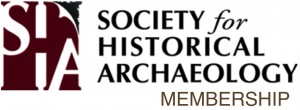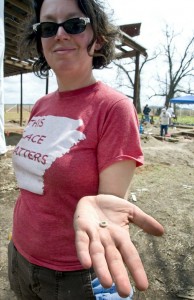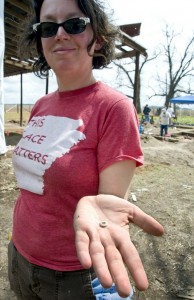 Here’s the latest in our series of entertaining interviews with a diverse array of your fellow SHA members. Meet a member for the first time or learn something about a colleague that you never knew before. This blog series also offers current members an opportunity to share their thoughts on why SHA membership is important (Camaraderie? Professional service? Exchange of ideas in conference rooms and beyond? You tell us!). If you would like to be an interviewee, please email the Membership Committee Social Media Liaisons Eleanor Breen (ebreen@mountvernon.org) or Kim Pyszka (kpyszka@aum.edu).
Here’s the latest in our series of entertaining interviews with a diverse array of your fellow SHA members. Meet a member for the first time or learn something about a colleague that you never knew before. This blog series also offers current members an opportunity to share their thoughts on why SHA membership is important (Camaraderie? Professional service? Exchange of ideas in conference rooms and beyond? You tell us!). If you would like to be an interviewee, please email the Membership Committee Social Media Liaisons Eleanor Breen (ebreen@mountvernon.org) or Kim Pyszka (kpyszka@aum.edu).
Jodi A. Barnes received her Ph.D. in Anthropology from American University in Washington, DC. She is currently a Station Archeologist and a Research Assistant Professor with the Arkansas Archeological Survey, a unit of the University of Arkansas system. Her research interests include the archaeology of the African diaspora, the U.S. Home Front, and public archaeology. She recently published the edited volume, The Materiality of Freedom: Archaeologies of Post-Emancipation Life.
 What is the first site you worked on? What is the last one (or current one)?
What is the first site you worked on? What is the last one (or current one)?
The first field site I worked on was the Kolb Site in South Carolina with Chris Judge and Carl Steen. They hold a dig at the multi-component site during spring break each year and volunteers and students come from all around to participate. I loved getting my hands dirty, the sore muscles and the excitement of touching the past. It was the first place I saw public archaeology in action and the start of great friendships. Currently, as a public archeologist with the Arkansas Archeological Survey, I am working on two projects, a World War II prisoner of war camp and a plantation. I try to make those projects fun and welcoming learning experiences similar to the Kolb site.
Fieldwork or labwork?
I’m not an either/or person when it comes to lab and fieldwork. I think they are both important and I enjoy doing both. When I was looking for a Ph.D. topic, my advisor, Joan Gero, encouraged me to do a project that built upon previously excavated collections. I was afraid that I might not be as marketable if my dissertation didn’t include fieldwork, so I opted to do fieldwork in the Blue Ridge Mountains of Virginia. But the importance of working on collections that have not been written up has stayed with me and I am currently trying to develop public programs that emphasize both the lab and the field.
What are you currently reading?
I am currently reading Laurie Wilkie’s (2014) new introduction to archaeology, Strung Out on Archaeology: An Introduction to Archaeological Research. I am using it in my class this spring. I am also reading a collection of short stories by Ron Rash. I love his storytelling and the way he draws the southern Appalachian landscape.
What did you want to be when you grew up?
When I was growing up, I wanted to be a fashion designer. This is difficult for most people who know me know to believe. I still think about it in terms of stylish, fashionable and versatile clothing for women who move between the field and the office or conference presentation. But the world of fashion design was not for me, so I switched to journalism. At that time, my ideal writing assignment would have been an article for National Geographic. That’s where I found anthropology and it is a good thing I wanted to write.
At what point in your career did you first join SHA? Why are you a member of SHA?
I joined SHA as a Ph.D. student. I attended my first conference in 2007 in Williamsburg, Virginia and I have been a member since then. I‘ve continued to be a member because of the collegiality, knowledge sharing, and community. I look forward to seeing my colleagues each year, attending symposiums, hearing about their ongoing projects, and learning new things, but also as importantly talking about our work over beers.
Which benefit of belonging to SHA do you find the most beneficial?
Getting involved with the SHA committees is one of the most valuable benefits of being a member of SHA. In 2007, Linda Ziegenbein told me she was going to the Student Sub-Committee meeting. This is a sub-committee of the Academic and Professional Training Committee (APTC). Immediately, I was recruited to manage the student listserv. I got to know students around the country who were interested in topics similar and different from me. We co-authored articles for the SHA Newsletter and organized panels. Later, I became more involved with APTC and helped with a number of projects including the syllabus clearinghouse project and the student paper competition. Later I got involved with the Gender and Minority Affairs Committee. It has been great to be involved in the work committee members are doing on mentoring, anti-racism, and developing fellowships. Being active in SHA committees, I have developed great friendships, but I also feel like I am playing an active role in shaping the future of historical archaeology (and I will always be grateful that I read the 1983 edited volume by Joan Gero, Michael Blakey and David Lacy about the socio-politics of archaeology, for making me realize how important this is).
Which article from Historical Archaeology has been the most influential to you?
Selecting one article that has been most influential is very difficult. But Carol McDavid and David Babson’s 1997 thematic issue, “In the Realm of Politics: Prospects for Public Participation in African-American and Plantation Archaeology,” (1997, Issue 31, volume 3) ranks high on the list. The authors underscored the fact that archaeology should be “useful” and that public archaeological practice is inherently political, especially when it deals with the archaeologies of disenfranchised peoples.

